Arthropods are the largest group of animals on earth, and parks such as White Sands National Monument (NM) support thousands of species of arthropods compared to tens or hundreds of species of vertebrate animals and vascular plants respectively. The vertebrate animals and vascular plants of the Chihuahuan Desert have been named and studied by scientists for many years, yet we know relatively little about the arthropods.
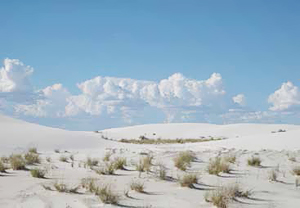
© David Lightfoot
When surveys are conducted in the Southwest, the discovery of new species (i.e., not yet scientifically named and recognized) of arthropods is not uncommon, especially in areas with unique environments. Not only do arthropods dominate the taxonomic composition and biomass of terrestrial biological communities, but they also represent key ecological functional groups such as detritivores, herbivores, predators, pollinators, and they serve as important food resources to vertebrate predators. In order to understand park natural resources and ecosystem processes, arthropod inventory studies are needed. Knowing what species of arthropods occur at particular parks will enable resource managers to better plan and implement management of the park’s species and their habitats, especially endemic (geographically restricted to that area) species that are dependent upon proper management of their habitats within those parks for their existence.
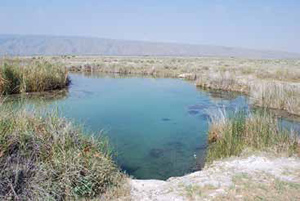
© David Lightfoot
The purpose of this research is to survey the arthropods of White Sands National Monument, New Mexico, USA, and Cuatrociénegas Protected Area, Coahuila, Mexico, specifically to discover new unnamed and potentially endemic species. Both areas are located within the Chihuahuan Desert, and both areas are desert basins with gypsum deposits, including gypsum flats, gypsum outcrops, gypsum dunes, and surface waters in the form of springs, ponds, and streams. This project is a U.S. National Park Service, Sister Parks Program-funded study, awarded to White Sands NM, and to the Biology Department, University of New Mexico, Museum of Southwestern Biology, Division of Arthropods. This arthropod survey began in 2010 and will end in 2014.
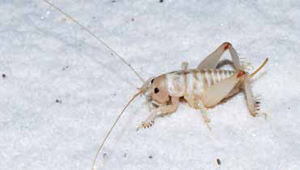
© David Lightfoot
Prior to this survey, only two species of crickets that were named in 1947, and two species of moths that were named in 2009, were known to be endemic to White Sands NM. A similar survey of the moths of White Sands NM, concurrent with this study, has resulted in the discovery of even more new moth species.
From the 1960s through the 1980s, 14 arthropod species were discovered and described from Cuatrocienegas protected area in Coahila, Mexico by various researchers working independently, and all 14 appear to be endemic there. However, no comprehensive survey for arthropods has ever been conducted at Cuatrocienegas prior to this study. Arthropod species that are endemic to the gypsum dunes and soils at both White Sands and Cuatrocienegas are adapted to live specifically on or in those gypsum substrates. Most are white or pale in color for camouflage, and species that live in the sand have modified legs and body shapes to enhance their ability to burrow through the sand.
Methods
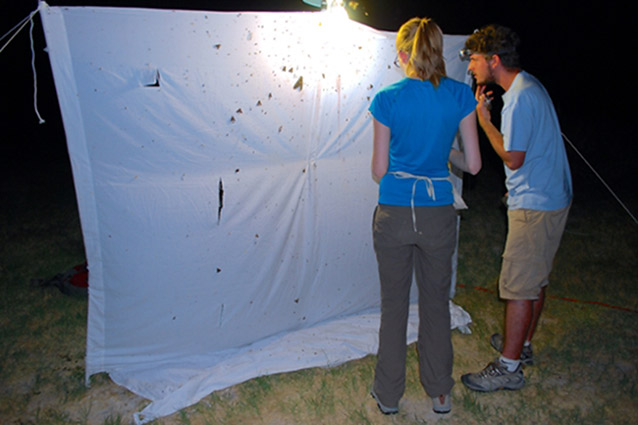
© David Lightfoot
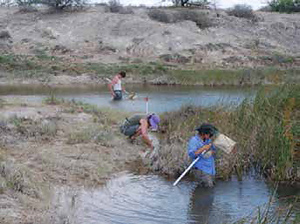
© David Lightfoot
This survey focuses only on certain arthropod groups (orders, families, and genera) for which we could find taxonomic experts willing to perform specimen identifications to the species level. This involved approximately 20 experts for approximately 70 taxonomic groups of arthropods, representing hundreds of species in those groups. A variety of common arthropod sampling or collecting methods are being used to survey arthropods in the two parks, including active search and capture, sweep nets for arthropods on vegetation, dip nets for aquatic arthropods, pitfall traps for arthropods on the ground surface, aerial nets for flying insects, and ultraviolet and mercury vapor lights and light traps for night-flying insects. Field surveys were designed to target arthropods of those groups, and to target the principal terrestrial and aquatic habitats present in both parks. Different arthropod species are active at different seasons and at different times of day or night, so surveys are being conducted throughout the spring, summer, and fall months and at different times of day and night.
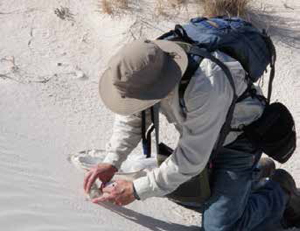
© David Lightfoot
All specimens collected on survey trips were taken to the Museum of Southwestern Biology at the University of New Mexico (UNM), and prepared as museum specimens. Most insects were mounted on insect specimen pins and allowed to dry, while soft-bodied arthropods such as spiders, scorpions, crustaceans, crickets, and insect larvae were field collected into ethanol and transferred to museum storage containers where they remain preserved in ethanol. All specimens were provided with a specimen data label containing information on where and when they were collected, as well as any habitat information, collection method, and who collected each specimen. Those museum specimens were then sent to the appropriate taxonomic experts for identification. The taxonomic experts provide identifications to the species level for already named species, and report any specimens that appear to be new, unnamed species. The taxonomic experts may proceed with formal scientific species descriptions, or in most cases, species will be formally named at a later time. Once taxonomic identifications of named species and determinations of unnamed species have been made, the specimens are returned to UNM, and all information is entered into an electronic database. All specimens remain housed in the Division of Arthropods unless taxonomic experts request the loan of specimens to describe new species.
Results and Discussion
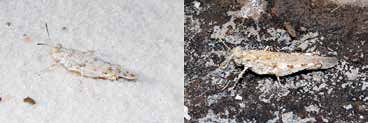
Examples of new, endemic species of grasshoppers found in this survey study. Cibolacris new species (above left), restricted to gypsum sand at the bases of dunes at White Sands NM and Anconia new species (above, right), restricted to damp saline/gypsum soil on flats near permanent water at Cuatrocienegas.
© David Lightfoot
Most of the field survey work is completed as of 2013 and lab work and taxonomic expert identifications are in progress. Thus far, we have found five species of arthropods from White Sands NM that were previously unknown, and likely endemic, including three grasshoppers, one fly, and one moth. We have found 11 species of arthropods from Cuatrocienegas that appear to be new and possibly endemic, including one sand cockroach, three grasshoppers, three katydids, one darkling beetle, one moth, and one spider. More new species may be discovered as taxonomic experts evaluate specimens collected from this study over the next year or so.
Management Implications
We have not attempted to survey or evaluate other taxonomic groups of arthropods, and once this particular inventory survey is completed, additional arthropod species are likely to be discovered at both parks. Additional future arthropod surveys should be conducted when taxonomic experts are available for those other groups. Our findings of several new and endemic species of arthropods at both White Sands NM and Cuatrocienegas now provide both parks with more information on the biota of their parks and knowledge of additional special status species to include in natural resource management plans. These newly found arthropod species will likely be further studied by scientists conducting research on animal adaptations to gypsum and desert environments, biological evolution and speciation, and biogeography.
For more information, contact:
David C. Lightfoot, dlightfo@unm.edu
Kelly B. Miller, kbmiller@unm.edu
Museum of Southwestern Biology
Department of Biology
University of New Mexico
Prepared by Chihuahuan Desert Network Inventory and Monitoring Program, 2013.
Last updated: February 1, 2017
